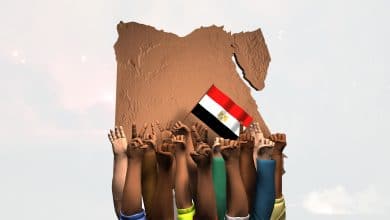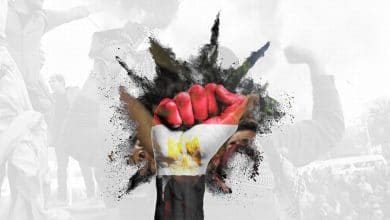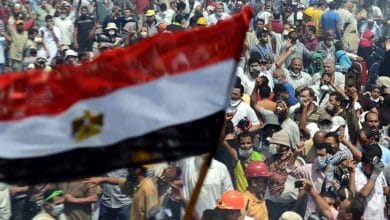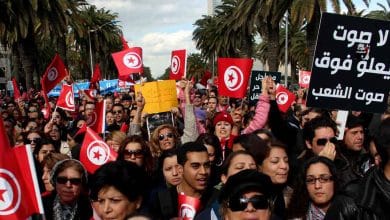
Egypt: Protests to Set Limits for Gov. Policies
Egypt had already witnessed a popular movement in September of last year, after Egyptian businessman “Mohamed Ali” on September 20, 2019, called on Egyptians to gather in front of their homes in protest against Sisi’s corrupt regime, under the guise of football fans supporting their favorite teams immediately after a football match between Al-Ahly and Zamalek, the two main football teams in Egypt.
On that day, the Egyptian youth surprised the opposition elite both at home and abroad by bypassing the call to protest in front of their homes, and they took to the street in large rallies that stormed the icon of the January 25 squares or the “forbidden square”, that is Tahrir Square, in addition to other squares such as Al-Qaed Ibrahim Square in Alexandria, and Al-Arbaeen Square in Suez, and others, breaking the “fear barrier” – as many observers of Egyptian affairs used to call it – due to the unprecedented repressive measures that the post-July 3 authorities have practiced and threatened to further practice (in case of eruption of any protests)[1].
The regime’s levying approach and its future implications
The Egyptian citizen faces a levying policy adopted by the current regime, which is characterized by several aspects, most notably:
– Devoting the state’s tendency to withdraw from provision of social services and converting them into highly paid services,
– The structural growth of this levying approach as a result of devotion of a huge external debt and attempting to curb it with financial bubbles that are based on foreign debt as well,
– The performance of the State in implementing this levying policy is characterized by brutality, as it targeted the daily sources of living of Egyptians such as energy, electricity, water and natural gas; and its scope gradually expanded to reach people’s homes as well, which led to renewal of protests.
– This levying approach is characterized by absence of legal legitimacy in some paths, in addition to overlooking corruption situations that have led to normalization with construction violations in terms of providing violating buildings with its needs of water, electricity and gas,
– Finally, there is a contradiction in the authorities’ statements on the crisis related to the building violation law.
Features of the September 2020 protests
It can be said that protests continue on a daily basis in Egypt. The Arab Network for Human Rights Information’s Social Movements Observatory documented in its periodic report 75 labor and social protests during the period from June to August 2020, with 60% for labor and professional protests and 40% for social protests[2]. One of the most prominent recent protests was the protest organized by hundreds of workers and administrators in the “Delta Chemicals” company, where they organized successive protests over the past few days in rejection of sale or privatization of the company[3].
However, the government’s concerns about the building violation protests lie in the fact that they these protests are general and liable to develop into a broader public movement. The most dangerous aspects of these protests is what activists monitored on social networking sites that the demand for Sisi’s departure was not only required by the opposition, but also by supporters of the post-July 3 (2013) authorities – all those who were affected by the government’s economic and social policies, most recently the demolition of their homes due to allegedly lacking legal building permits.
Some observers pointed out that the Sisi regime’s delay in understanding the messages of people’s wrath led the protests to turn from economic demands into political chants that have escalated up to demanding Sisi to leave, a demand that has become strongly present in the Egyptian streets, after it had been limited to only social networking sites due to the brutal security repression[4].
The current protests are characterized by several features, most prominently:
A- The protests have been predicted:
On the one hand, the Egyptian government was anticipating a widespread scale of protests, where on August 28, authorities arrested the acting leader of the Muslim Brotherhood, Mahmoud Ezzat, who had been in absentia sentenced to death and life imprisonment in several cases. Some observers estimate that the arrest of Ezzat came within the framework of the regime’s desire to control the group’s likely role in the September protests.
The Egyptian authorities reapplied last year’s security plan to confront the September 20 demonstrations called for by prominent opposition figures and activists, as security forces were deployed in squares and streets, with the erection of checkpoints that have started to stop passers-by, check their cell phones, and search for people’s access to social media applications such as: Facebook and Twitter to find out the political affiliations of likely ‘detainees’.
The authorities on September 14 closed cafes and ordered their owners not to reopen except after receiving new security instructions, justifying the closure of those cafes with various pretexts.
These security measures that preceded the September 20 calls for demonstrations by businessman Mohamed Ali, have become a regular measure that cannot be seen as a precedent. However, what is remarkable about the post-July 3 authorities’ precautionary approach is the broadcasting of patriotic songs via local radio stations, a behavior that has been denounced by a segment of the Egyptian elite[5].
B- There are many reasons for the protests:
On the other hand, the scope of protests was not limited to objection to the building violations law. On Tuesday, September 9, 2020, the Egyptian Public Prosecution announced the start of an investigation into the killing of a young man identified as Islam El-Australi, an incident that caused widespread protests in Giza’s Al-Muneeb district[6], west of Greater Cairo, where the mother and sister of the deceased young man accused police officers who had arrested him of killing him. This incident led to outbreak of angry protests in the Muneib St., despite warnings of the Covid-19 pandemic, as hundreds of young people gathered in the Muneeb area, according to pictures published by accounts on the social networking sites, such as Facebook and Twitter, where protesters chanted angry slogans, most notably “The Interior Ministry is a group of thugs”. However, the Interior Ministry indicated, in a statement circulated by various media outlets, that the young man died as a result of a quarrel with others, not as a result of the alleged security forces’ assault on him[7].
Also, the 10th of Ramadan city protests in 2020[8], which ended with the escape of the security forces after protesters had thrown Molotov cocktails at their vehicles, were not due to the demolition of houses, according to the video clip that recorded the incident, but there was a confrontation between a number of young men and the two police patrol cars, where the forces at the end fled. However, a statement of the Interior Ministry explained the incident as a “quarrel” between two parties of citizens that resulted in the arrest of both sides[9].
C- Expansion of the geographical scope of protests:
The protests related to the building law violations started to be monitored with the circulation of a video clip by Facebook users, where on August 27 dozens of people from the Seriaqos area in Khanka, Qalyubia governorate, appeared while throwing stones at bulldozers that were going to demolish a number of violating houses[10]; and the security forces arrested fifteen of them[11]. From Khanka, the protests moved to Cairo (Al-Duweiqa area), to Alexandria (Al-Mansheya area)[12], to Giza (Al-Kadaya village),[13] up to the Tenth of Ramadan City[14]. Also, the social networking sites circulated video clips showing the residents’ resistance of the security forces in Port Said and Suez (northeastern Egypt), and the Assiut governorate (in Upper Egypt)[15].
During these protests, there were limited altercations between supporters and critics of demonstrations, but in some areas there were violent incidents as happened in Assiut, where four policemen were killed at the hands of a property owner during an attempt to implement a razing decision – although the security services later denied the report[16], describing the report as completely groundless and coming within the framework of spreading rumors and lies with the aim of inciting public opinion.
In other areas, the confrontations developed into destroying police cars, as happened in the Kadaya village, and throwing Molotov cocktails at police cars, as happened in the Tenth of Ramadan City.
In Alexandria, demonstrators surrounded police vehicles of security forces, repeating chants against the government.
Commenting on the expansion of protests TV presenters Ahmed Moussa and Mustafa Bakri, both close to the security services, admitted the existence of a widespread state of anger among Egyptians, and urged the Egyptian government to take necessary precautions to face the dangers that threaten Egypt’s stability[17].
The number of people arrested during the protests until 10 September have reached about 234 citizens, according to the Mada Masr website”[18].
D- Continuity over a long period of time:
One of the features of these protests – unlike the September 2019 movement – is the fact that they have continued over a long period of time. The social networking sites recorded the first confrontation between citizens and the police on August 27. The clashes of the Tenth of Ramadan city and the Kedaya village took place on September 19 and 20, respectively. It is noteworthy in this context that while clashes at the beginning of protests appeared to be limited – as in the Mansheya area in Alexandria, however, with the passing of time, they have become more violent, which exposed simple Central Security Sector soldiers to danger and forced them to flee and run away after angry protesters had attacked troop carriers in the Tenth of Ramadan city, as shown by a video clip that was posted on social media, in addition to destruction of police cars in the village of Kedaya[19].
However, the Prime Minister’s appearance in a surprising press conference to talk about the crisis of demolishing illegal homes did not help ease the concerns of Egyptians or calm their protests that started to take an upward trend, although it seemed that the premier’s press conference targeted absorption the popular anger through issuance of a series of easing measures that were left to the estimates of governors[20].
E- Addressing various society categories:
In fact, the impression that prevailed among a sector of social media users that the law was only targeting the simple social strata, is not true. Rather, the Sisi regime’s levying approach affects all, including both simple citizens and the top of the pyramid of economic and financial influence, such as businessman Salah Diab. Also, the reconciliation decision regarding building violations includes erection of “pergolas” in the backyard of villas and farms, where such facilities only belong to wealthy Egyptians.[21].
Outlook for repercussions
Several observers both at home and abroad, compare the ongoing protests with their counterparts last year, pointing out that the mass demonstrations in Cairo and a number of governorates in 2019 did not gain a political leverage to lead them, due to the absence and exhaustion of most of the political entities that were behind the success of the January 25 revolution, the same scenario that was repeated in October, with the call of the “Egyptian Joker” on people to take to the street, which did not continue due to the absence of the same lever[22].
In a study by the researcher on the September movement, the paper referred to what the researcher called “the conditional movement”, as a characteristic of the September movement (2019), resulting from a high level of awareness of regional and global conditions, amid the regime’s propaganda that focus on intimidation of people and warning them of a similar fate of what happened in Syria and Iraq.
This awareness has led to a conviction that any expansion of the range of mobilization and protests depends on three preconditions: that is the availability of a leadership, the presence of a consensus among opposition elites, and the involvement of the armed forces in the arrangements for expansion of the popular movement.
These three conditions are, of course, based on the assessment of the researcher, as a result of his effort to explore the fears of the Egyptian street that wants a stable and protected transition, where there is no way for stability and protection except through the availability of those three conditions, that can branch out dozens of scenarios.
One of the features of the political scene revealed by the September 2020 protests is the success of the post-July 3 authorities in preventing any accumulation with respect to political reform, where all the hopes of the current centrist movement in Egypt lie in occurrence of a boom in the political maturity of the central decision-making circles in Egypt. Otherwise, the traditional tools used by the current Egyptian regime will remain a firm barrier in front of any likeliness of occurrence of change. Of course, this is the most likely explanation of the current situation in Egypt, because the alternative explanation would unfortunately be the inability to produce a vision for a promising political reform path by the opposition elite outside Sisi’s prisons [23].
Footnotes
[1] Wessam Fauad, Egypt’s Conditional Protest…, Egyptian Institute for Studies, October 25, 2019, Link.
[2] Egypt, Social Movements Observatory: 75 Social and Labor Protests during June-August 2020 (Infograph), Gohod website, September 17, 2020, Link.
[3] Egypt: Labor protests continue despite the epidemic and the security grip, Al-Araby Al-Jadeed newspaper, August 19, 2020, Link.
[4] Alexandria Protests, Beginning of Revolution against Sisi, Al-Sharq website, September 10, 2020, Link.
[5] Abdul Azim Hammad’s Facebook account, Link.
[6] Demonstrations in Moneeb, Giza to protest the killing of a young man, Diary of Shimou and Imam TV Channel, YouTube, September 7, 2020, Link.
[7] Egypt .. Investigation into a murder that sparked protests against police violence, Anadolu Agency, September 9, 2020, Link.
[8] Urgent!! The Egyptian police expelled from the 10th of Ramadan City today, September 20, 2020 … !!, Latest News Channel, YouTube, September 19, 2020, Link.
[9] Ayman Okasha, The Interior Ministry reveals the falsehood of Brotherhood’s claims in the Tenth of Ramadan City incident, Al-Ekhbariya website, September 19, 2020, Link.
[10] Have you seen “Hit oh guy”, Index Hakeem Twitter account, Twitter website, September 8, 2020, Link.
[11] Arrest of people who assaulted the police during the campaign to remove building violations in Khanka, Al-Diyar news website, August 27, 2020, Link.
[12] Protests in Egypt as the removal of building violations continues, Hashtag Program Facebook account, September 10, 2020, Link.
[13] Egyptians confront security forces and destroy some of their vehicles in the village of Kadaya, Giza, Al-Estiqlal newspaper’s Facebook account, Link.
[14] Urgent!! Egyptian police expelled from the 10th of Ramadan City. Op. Cit.
[15] Egypt … Continuous protests against government measures and Prime Minister calls on Egyptians to adhere to the reconciliation law to avoid demolishing their homes, Al-Jazeera Net, September 10, 2020, Link.
[16] Hundreds arrested in razing campaigns…, Mada Masr website, September 9, 2020, Link.
[17] Alexandria Protests, Beginning of Revolution against Sisi, Al-Sharq website, Op. Cit.
[18] Hundreds arrested in razing campaigns…, Mada Masr website, Op. Cit.
[19] Egyptians confront security forces and destroy some of their vehicles in the village of Kadaya, Giza, Op. Cit.
[20] Hassan Al-Masry, The Sisi regime approved formal facilitations … Has it feared popular unrest against the reconciliation law?, Al-Jazeera Net, September 10, 2020, Link.
[21] Ibid.
[22] Abdullah Hamed, Closing cafes and checking bystanders … Sisi seeks to abort the September 20 demonstrations in Egypt, Al-Jazeera Net, September 15, 2020, Link.
[23] The views expressed in this article are entirely those of the author’s and do not necessarily reflect the views of EIPSS.




